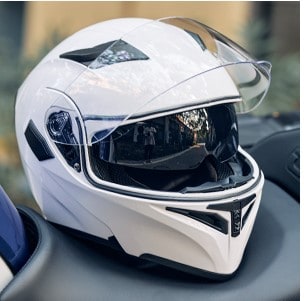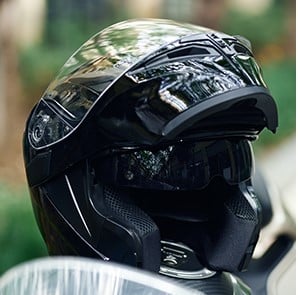Full face helmets, also known as full coverage helmets, have become popular in the bicycling sector as they are in the motorcycling sector. They are often advertised as the safest options, which brings us to this question, are full face helmets safer?
Research by Injury Epidemiology and Science Direct shows that full-face helmets are safer than open-face helmets. Yes, these helmets have a few safety concerns, but they offer the best protection to the chin bar and face, two of the most injury-prone areas on the head.
So, it doesn’t necessarily mean that you are injury-proof just because you are wearing a full-face helmet. No, things don’t work like that, as no helmet is 100% safe.
But if we are talking about the severity of the injuries, they are less severe when wearing a full-face helmet. But still, a full-face helmet may be a potential safety risk, as I’ll explain in this post.
So, why don’t we go straight to these risks? Here we go!

Safety Risks of Wearing a Full Face Bike Helmet
Here are reasons why most people think that full-face bike helmets are unsafe:
1. Limited Vision
There are two ways to look at this. First, there is the aspect of not having a broad view angle as your vision concentrates on the front. That can be alarming if the source of danger is coming from any other side other than the front.
You can address the issue by using the rear mirrors for motorcycles, but it isn’t much you can do with a bicycle. You are likely to face blind spots on the rear three-quarters.
The other risk is visor fogging. While the visor’s job is to protect your eyes and replace safety glasses, it can clog with fog, which may impair your visibility.
Luckily, this problem is fixable by spraying the visor with an anti-fog spray like the Muc Off Premium Anti-Fog Treatment.
The spray protects your bike visor and even goggles from fogging up in bad weather.
2. Hearing Restrictions
A full-face bike helmet is likely to block all noises. That means you cannot hear other riders and motorists or people shouting at you, which is good since you can concentrate on the road.
The danger is that you may not hear warning sirens and horns, so things could turn catastrophic for you if there’s a potential risk.
3. Overheating
Since a full-face helmet covers every part of your head, it’s likely to overheat, and things may become uncomfortable for you. The more uncomfortable and uneasy you become, the less focused you become, which is risky since you cannot make better decisions on the road.
That is likely to happen when you ride long distances under the scorching sun. But even so, the helmet you are wearing has a say. You can expect it to overheat if it’s not breathable. Luckily, most modern full-face helmets come with lots of ventilation channels, which helps in reducing heat build-up.
4. Extra Weight
Logically speaking, full-face helmets are weightier than open-face helmets as they cover the whole face. The problem is that the excess weight may become too uncomfortable on your head.
However, the good news is that helmet manufacturers are becoming more innovative by the day and are now making lighter full-face helmets. So, it’s important to shop wisely to buy the most lightweight full face mountain bike helmet you can find.
But Does That Mean Open Face Bike Helmets Are Safer?
After looking at the above safety risks, it’s easy to assume that open-face bike helmets are safer than full-face.
Well, the answer is no. According to Injury Epidemiology, full-face helmets lower the risk of sustaining facial injuries. Science Direct also has the same analysis, claiming that a full-face helmet offers better protection to the chin and face, two areas that are more injury-prone during crashes.
And according to Micra Moto, full-face helmets are at least 45.3% safer and better than any other bike helmet. So, open-face bike helmets are not safer than full-face.
Yes, open-face helmets are lighter, more ventilated, and greater for warmer zones than full-face, but the fact that they don’t protect your face and chin area makes them less safe.

Why Are Full Face Helmets Safer?
Now that both studies by Injury Epidemiology and Science Direct confirm that full-face helmets are safer than open-face helmets, you are likely to ask, why is that the case? Well, that’s because of these three reasons:
1. Full Face Helmets Offer the Most Head Coverage
Both Injury Epidemiology and direct science studies conclude that full-face helmets are safer because they protect the face and chin.
They even cover the skull base, a notable injury-prone area during crashes. While this doesn’t make full-face helmets 100% safer, it promises a lower injury risk.
2. Full Face Helmets Mostly Offer Eye Protection
I’ve used ‘mostly’ because not all full-face helmets come with visors. While visors can be a safety risk if they fog up, that’s ordinarily preventable with an anti-fog spray I mentioned earlier.
Some helmets even come with anti-fog visors, like the ILM Full Face Helmet. You don’t have to worry about the fog or buy an anti-fog spray in such a case.
Overall, the visor protects your eyes from potential dangers such as dust, stones, mud, and anything else that may interfere with your vision and cause you to crash.
While you can pair an open-face helmet with goggles, they won’t offer the same protection as a helmet visor.
3. Full Face Helmets Are Often Thicker, Thus Safer.
On one side, the fact that full-face helmets are heavier is a sign of discomfort. On the other, the thick material means double cushioning during a crash.
So, while it’s advisable to go for the most lightweight full-face helmet, full-face helmets will always weigh more than their open-face siblings.
4. Full Face Helmets Protect Against Adverse Weather
The safest full face helmets provide more protection against harmful weather elements like direct sun, rain, and strong wind. Often, these weather elements affect the rider’s comfort and concentration level, more so when cycling at high speed.
Even worse, too much sunray exposure could cause vision problems, while the extra wetness from the rain could make you sick. So, that again proves that full-face helmets are safer.
5. Full Face Helmets Offer Better Protection Against Stinging/Biting Insects
Dust, mud, and harmful weather agents are not the only threats when riding. There are also stinging and biting insects such as bugs and mosquitoes, which could attack the exposed areas of your face if you are only wearing an open-face helmet.
That’s often the case for serious trail riders and tourers. A full-face helmet will offer you more protection against these ferocious insects and boost your chances of having a fun riding adventure.
6. Full Face Helmets Offer Better Protection Against Distracting Noises.
Yes, you may not hear the traffic sounds, sirens, and horns, which means you won’t be conscious of your surroundings.
On the brighter side, the helmet blocks off the noisy motorists, people shouting at you, and all manner of distractions to allow you to concentrate on your ride. Essentially, this is important for commuter cyclists in noisy neighborhoods.

How to Find the Safest Full Face Helmet
Now that it’s clear that full-face helmets are much safer than their open-face cousins let’s help you find the safest option. Ideally, you can find the safest full-face bike helmet by considering the following:
a) Helmet Certification
Not all full-face helmets meet the necessary standards, which means they aren’t certified to be safe. Ideally, there are three bodies known to certify bike helmets worldwide.
- US Department of Transportation (DOT) –The DOT is responsible for regulating helmets sold in the US.
- Economic Commission for Europe (ECE) – While the DOT regulates and certifies in the US, the ECE does the same in Europe.
- Snell – Snell is an independent body that tests and certifies bike helmets all around the globe.
Overall, it’s important to double-check the bike helmets to confirm if it has the standardization mark by any of these bodies or any other recognized independent body.
b) Specialized Technology
You can also identify a safe full-coverage helmet from the safety-focused technology. The three most notable specialized helmet technologies are:
- MIPS (Multi-directional Impact Protection System) – MIPs technology offers protection against rotational impact, making MIPs helmets among the most effective in preventing brain injuries.
- SPIN (Shearing Pads Inside) – SPIN helmet technology redirects rotational force in the event of a crash by employing silicone injected pads. It borrows the same principle as MIPs, thus effective.
- WaveCel – WaveCel is Bontrager’s patented helmet technology that creates a crumple zone for absorbing both rotational and direct impact. As a result, most experts consider WaveCel helmets to offer the most impact protection.
c) Helmet Fit
Don’t forget to get a helmet that fits you, as the wrong size could be a safety risk. The helmet should be snug, and below is a helmet sizing guide you can use.
Note that you can tie a tape measure around your head to determine its circumference.
| Head Circumference | Helmet Size |
| Below 51 cm | Extra-small |
| 51 – 55 cm | Small |
| 55 – 59 cm | Medium |
| 59 – 63 cm | Large |
| 63 cm | Extra large |
| One-size fits all | Adjustable fit |
Which Full-Face Helmet Is Best?
Here are some full-face helmets that meet the shared certification requirements, employ specialized technologies, and come in comfortable sizes:
- ROCKBROS Kids Bike Helmet: Best full face kids’ helmet
- Bell Sanction Adult Full Face Helmet: Best full face BMX and dirt jumper helmet
- Troy Lee Designs Helmet Camo: Best full face MTB helmet
People Also Ask
1. Are Full Face Helmets Required?
While no law demands that you wear a full-face helmet, these helmets offer the most facial protection making them necessary for serious biking in harsh conditions.
2. Is A Full-Face Helmet Safer for Mountain Biking?
A full-face helmet protects your face and chins more than an open-face helmet. As a result, a full-face helmet is safer, especially against adverse weather, dust, and insects.
3. Is Full Face Helmets Better?
A full-face helmet promises the most coverage and protection, thus better in extreme weather, noisy roads, and insect-prone zones.
Are Full Face Helmets Safer? Closing Thought!
According to Injury Epidemiology and Science Direct expert studies, while full-face helmets have a few safety concerns, they are safer than their open-face counterparts.
The reasons are obvious– full-face helmets offer the most protection for the face and chin area, guaranteeing a lower facial injury risk.
Also Read: